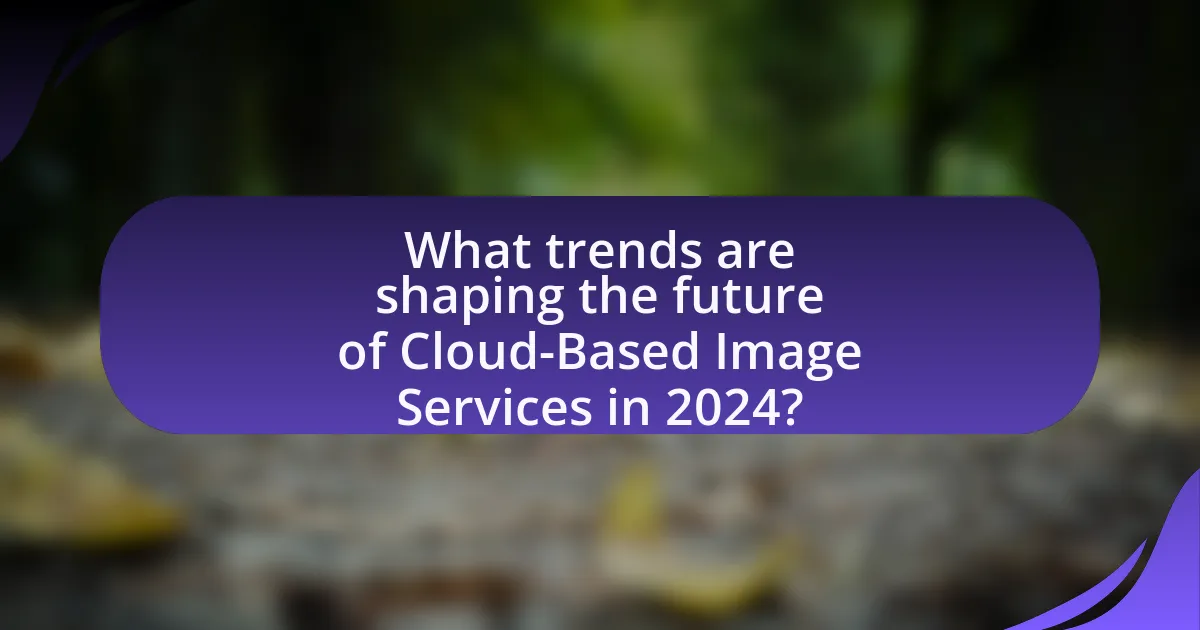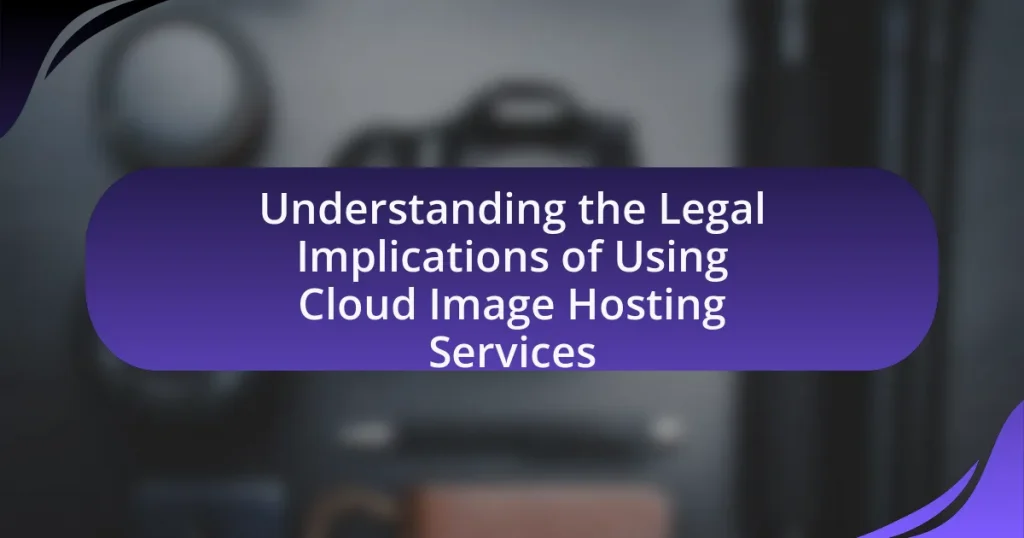Cloud-based image services are online platforms that utilize cloud computing technology to store, manage, and manipulate images, allowing users to access their content from any internet-connected device. The article explores the functioning of these services, the technologies that underpin them, and the key benefits they offer, such as scalability, cost-effectiveness, and enhanced accessibility. It also examines the influence of artificial intelligence on image processing, the importance of security measures, and the regulatory challenges faced by providers. Additionally, the article highlights emerging trends shaping the future of cloud-based image services in 2024, including advancements in AI, real-time processing demands, and evolving security protocols.
What are Cloud-Based Image Services?

Cloud-based image services are online platforms that allow users to store, manage, and manipulate images using cloud computing technology. These services enable users to access their images from any device with internet connectivity, facilitating collaboration and sharing. According to a report by MarketsandMarkets, the cloud image processing market is projected to grow from $1.2 billion in 2020 to $4.5 billion by 2025, indicating a significant demand for such services.
How do Cloud-Based Image Services function?
Cloud-based image services function by utilizing remote servers to store, process, and manage images, allowing users to access and manipulate their images via the internet. These services typically involve uploading images to a cloud platform, where they are stored securely and can be accessed from any device with internet connectivity. The processing capabilities of these services often include image editing, resizing, and format conversion, which are performed on powerful cloud servers rather than local devices. This model enables scalability, as users can easily increase storage and processing power as needed, and it enhances collaboration by allowing multiple users to access and edit images simultaneously. The effectiveness of cloud-based image services is supported by the growing demand for digital storage solutions, with the global cloud storage market projected to reach $137.3 billion by 2025, indicating a significant trend towards cloud adoption for image management.
What technologies underpin Cloud-Based Image Services?
Cloud-Based Image Services are primarily underpinned by technologies such as cloud computing, artificial intelligence, machine learning, and image processing algorithms. Cloud computing provides the infrastructure for storage and scalability, enabling users to access and manage images remotely. Artificial intelligence and machine learning enhance image recognition and classification, allowing for automated tagging and organization of images. Image processing algorithms facilitate the manipulation and enhancement of images, ensuring high-quality outputs. These technologies collectively enable efficient, scalable, and intelligent management of image data in cloud environments.
How do these technologies enhance image processing capabilities?
Cloud-based image processing technologies enhance image processing capabilities by leveraging advanced algorithms and scalable computing resources. These technologies enable real-time processing, allowing for faster image analysis and manipulation, which is crucial for applications such as facial recognition and object detection. For instance, cloud platforms can utilize machine learning models that improve accuracy and efficiency in image classification tasks. Additionally, the ability to store and access vast amounts of data in the cloud facilitates the training of more sophisticated models, leading to better performance in image enhancement and restoration.
What are the key benefits of using Cloud-Based Image Services?
Cloud-Based Image Services offer scalability, cost-effectiveness, and accessibility. These services allow users to store and manage large volumes of images without the need for extensive local infrastructure, reducing overhead costs associated with hardware and maintenance. Additionally, they provide easy access to images from any location with internet connectivity, facilitating collaboration and sharing among teams. According to a report by Gartner, organizations that adopt cloud services can reduce IT costs by up to 30%, highlighting the financial advantages of using such services.
How do Cloud-Based Image Services improve accessibility for users?
Cloud-based image services improve accessibility for users by enabling seamless access to images from any device with internet connectivity. This flexibility allows users to retrieve, share, and collaborate on images without being restricted by hardware limitations or geographical barriers. According to a report by Gartner, 70% of organizations that adopt cloud services experience enhanced collaboration and productivity, demonstrating the significant impact of cloud-based solutions on user accessibility.
What cost savings can businesses expect from adopting these services?
Businesses can expect significant cost savings from adopting cloud-based image services, primarily through reduced infrastructure expenses and operational efficiencies. By utilizing cloud services, companies eliminate the need for extensive on-premises hardware, which can incur high capital expenditures and maintenance costs. For instance, a study by Gartner indicates that organizations can save up to 30% on IT costs by migrating to cloud solutions. Additionally, cloud-based services often provide scalable pricing models, allowing businesses to pay only for the resources they use, further optimizing their budget. This flexibility can lead to lower overall costs compared to traditional image processing methods.
What trends are shaping the future of Cloud-Based Image Services in 2024?

The future of Cloud-Based Image Services in 2024 is being shaped by advancements in artificial intelligence, increased demand for real-time processing, and enhanced security measures. Artificial intelligence is driving automation in image recognition and editing, allowing for more efficient workflows and improved user experiences. The demand for real-time processing is growing as businesses seek to deliver instant results, particularly in sectors like e-commerce and social media, where speed is crucial. Additionally, enhanced security measures are becoming essential due to rising concerns over data privacy and cyber threats, prompting service providers to implement stronger encryption and access controls. These trends indicate a significant evolution in how cloud-based image services will operate and meet user needs in 2024.
How is artificial intelligence influencing Cloud-Based Image Services?
Artificial intelligence is significantly enhancing cloud-based image services by automating image recognition, improving image quality, and enabling advanced analytics. AI algorithms can analyze and categorize vast amounts of images quickly, allowing for efficient organization and retrieval of visual content. For instance, companies like Google and Amazon utilize AI-driven tools for image tagging and search optimization, which streamlines user experience and increases accessibility. Additionally, AI techniques such as deep learning enhance image resolution and restoration, making it possible to improve the quality of images stored in the cloud. This integration of AI not only boosts operational efficiency but also provides valuable insights through data analysis, thereby transforming how businesses manage and utilize visual content in cloud environments.
What specific AI applications are emerging in image processing?
Specific AI applications emerging in image processing include automated image enhancement, object detection, and image segmentation. Automated image enhancement utilizes deep learning algorithms to improve image quality by adjusting brightness, contrast, and sharpness, significantly benefiting industries like photography and e-commerce. Object detection employs convolutional neural networks (CNNs) to identify and classify objects within images, which is crucial for applications in autonomous vehicles and security systems. Image segmentation, which divides an image into meaningful parts, is increasingly used in medical imaging for precise diagnosis and treatment planning. These applications are supported by advancements in neural networks and large datasets, enhancing their effectiveness and accuracy in real-world scenarios.
How does AI improve the efficiency of image management?
AI improves the efficiency of image management by automating tasks such as image tagging, sorting, and retrieval. This automation reduces the time and effort required for manual organization, allowing for quicker access to relevant images. For instance, AI algorithms can analyze image content and generate metadata, enabling faster searches and improved accuracy in locating specific images. According to a study by McKinsey, organizations that implement AI in their workflows can increase productivity by up to 40%, demonstrating the significant impact of AI on operational efficiency in image management.
What role does security play in the evolution of Cloud-Based Image Services?
Security is fundamental to the evolution of Cloud-Based Image Services as it ensures the protection of sensitive data and maintains user trust. As these services have grown, the increasing volume of images stored in the cloud has made them attractive targets for cyberattacks, necessitating robust security measures such as encryption, access controls, and compliance with regulations like GDPR. For instance, a report by Cybersecurity Ventures predicts that global spending on cybersecurity will exceed $1 trillion from 2021 to 2025, highlighting the critical investment in security to safeguard cloud services. This emphasis on security not only protects user data but also drives innovation in cloud technologies, as providers develop advanced security features to differentiate themselves in a competitive market.
What are the latest security measures being implemented?
The latest security measures being implemented in cloud-based image services include advanced encryption protocols, multi-factor authentication, and AI-driven threat detection systems. These measures enhance data protection by ensuring that images are encrypted both in transit and at rest, making unauthorized access significantly more difficult. Multi-factor authentication adds an additional layer of security by requiring users to verify their identity through multiple methods, thereby reducing the risk of credential theft. AI-driven threat detection systems continuously monitor for unusual activity, allowing for real-time responses to potential security breaches. These measures are increasingly adopted as organizations prioritize the protection of sensitive visual data in the evolving landscape of cloud services.
How do these measures protect user data and privacy?
These measures protect user data and privacy by implementing robust encryption protocols and strict access controls. Encryption ensures that data is transformed into a secure format that is unreadable without the appropriate decryption key, thereby safeguarding sensitive information from unauthorized access. Strict access controls limit who can view or manipulate data, ensuring that only authorized personnel can access user information. For instance, according to a 2022 report by the Cloud Security Alliance, organizations that adopted advanced encryption and access management practices saw a 30% reduction in data breaches, highlighting the effectiveness of these measures in enhancing user privacy and security.
What are the challenges facing Cloud-Based Image Services in 2024?

Cloud-Based Image Services in 2024 face several challenges, including data security, bandwidth limitations, and increasing competition. Data security remains a critical concern as cyber threats evolve, necessitating robust encryption and compliance with regulations like GDPR. Bandwidth limitations can hinder the performance of these services, especially with high-resolution images, impacting user experience. Additionally, the market is becoming saturated with numerous providers, making it difficult for companies to differentiate their offerings and maintain profitability. These challenges require ongoing innovation and strategic planning to ensure service reliability and customer satisfaction.
What technical challenges do providers encounter?
Providers encounter several technical challenges, including data security, scalability, and integration with existing systems. Data security is critical as providers must protect sensitive information from breaches, which is increasingly challenging with the rise of cyber threats. Scalability issues arise when providers need to accommodate growing amounts of data and user demands without compromising performance. Additionally, integration challenges occur when cloud-based image services must work seamlessly with legacy systems, which can lead to compatibility issues and increased operational complexity. These challenges are significant as they directly impact the efficiency and reliability of cloud-based image services.
How do latency and bandwidth issues affect service delivery?
Latency and bandwidth issues significantly hinder service delivery by causing delays and limiting data transfer rates. High latency results in slower response times, which can frustrate users and degrade the overall experience, particularly in real-time applications like video streaming or online gaming. Insufficient bandwidth restricts the amount of data that can be transmitted simultaneously, leading to buffering, lower image quality, and interruptions in service. For instance, a study by Cisco indicates that a 1-second delay in loading a webpage can lead to a 7% reduction in conversions, highlighting the critical impact of latency on user engagement and satisfaction.
What solutions are being developed to overcome these challenges?
Solutions being developed to overcome challenges in cloud-based image services include enhanced data compression algorithms, improved security protocols, and advanced machine learning techniques for image recognition. Enhanced data compression algorithms reduce storage costs and improve transfer speeds, addressing bandwidth limitations. Improved security protocols, such as end-to-end encryption and multi-factor authentication, protect sensitive image data from unauthorized access. Advanced machine learning techniques enhance image processing capabilities, enabling faster and more accurate image analysis, which is crucial for applications in various industries. These solutions are being actively researched and implemented to ensure the efficiency and security of cloud-based image services in 2024.
What regulatory challenges impact Cloud-Based Image Services?
Cloud-Based Image Services face regulatory challenges primarily related to data privacy, security compliance, and intellectual property rights. Data privacy regulations, such as the General Data Protection Regulation (GDPR) in Europe, impose strict guidelines on how personal data is collected, stored, and processed, affecting how image services manage user data. Security compliance requirements, including the Health Insurance Portability and Accountability Act (HIPAA) for healthcare-related images, necessitate robust security measures to protect sensitive information. Additionally, intellectual property rights issues arise when images are stored and shared, requiring services to navigate copyright laws and licensing agreements to avoid legal disputes. These regulatory frameworks create complexities that cloud-based image services must address to operate legally and effectively.
How do data protection laws affect service operations?
Data protection laws significantly impact service operations by imposing strict regulations on how organizations collect, store, and process personal data. These laws, such as the General Data Protection Regulation (GDPR) in Europe, require companies to implement robust data security measures, obtain explicit consent from users, and ensure transparency in data handling practices. Compliance with these regulations often necessitates changes in operational processes, including the adoption of advanced encryption technologies and regular audits to assess data protection measures. Failure to comply can result in substantial fines, which can affect the financial stability and reputation of service providers.
What compliance strategies are being adopted by providers?
Providers are adopting several compliance strategies, including implementing robust data encryption, conducting regular audits, and ensuring adherence to industry regulations such as HIPAA and GDPR. These strategies are essential for safeguarding sensitive information and maintaining trust with clients. For instance, a study by the Ponemon Institute found that organizations with strong encryption practices experienced 50% fewer data breaches, highlighting the effectiveness of such compliance measures. Additionally, regular audits help identify vulnerabilities and ensure that providers remain compliant with evolving regulations, thereby mitigating risks associated with non-compliance.
How can businesses effectively leverage Cloud-Based Image Services in 2024?
Businesses can effectively leverage Cloud-Based Image Services in 2024 by integrating advanced AI-driven image recognition and processing capabilities into their workflows. This integration allows for enhanced automation in tasks such as image tagging, categorization, and quality enhancement, which can significantly improve operational efficiency. For instance, companies utilizing services like Google Cloud Vision or Amazon Rekognition can automate the analysis of large image datasets, leading to faster decision-making and reduced manual labor costs. Additionally, the scalability of cloud services enables businesses to handle fluctuating image storage and processing demands without significant upfront investment, thereby optimizing resource allocation.
What best practices should organizations follow when adopting these services?
Organizations should prioritize a strategic approach when adopting cloud-based image services. This includes conducting a thorough needs assessment to identify specific requirements and objectives, ensuring alignment with business goals. Additionally, organizations should implement robust security measures, such as data encryption and access controls, to protect sensitive information.
Training staff on the new technologies and processes is essential for maximizing the benefits of these services. Furthermore, organizations should establish clear governance policies to manage data usage and compliance with regulations. Regularly reviewing and optimizing service performance will help organizations adapt to evolving needs and technologies.
These best practices are supported by industry reports indicating that organizations that adopt a structured approach to cloud service integration experience higher satisfaction and lower operational risks.
How can businesses measure the success of their Cloud-Based Image Services implementation?
Businesses can measure the success of their Cloud-Based Image Services implementation through key performance indicators (KPIs) such as user engagement, cost savings, and system performance metrics. User engagement can be assessed by tracking metrics like the number of active users, frequency of use, and user feedback, which indicate how well the service meets customer needs. Cost savings can be evaluated by comparing operational costs before and after implementation, including reductions in storage and maintenance expenses. System performance metrics, such as uptime, response time, and image processing speed, provide insights into the reliability and efficiency of the service. These metrics collectively offer a comprehensive view of the implementation’s effectiveness and alignment with business objectives.



